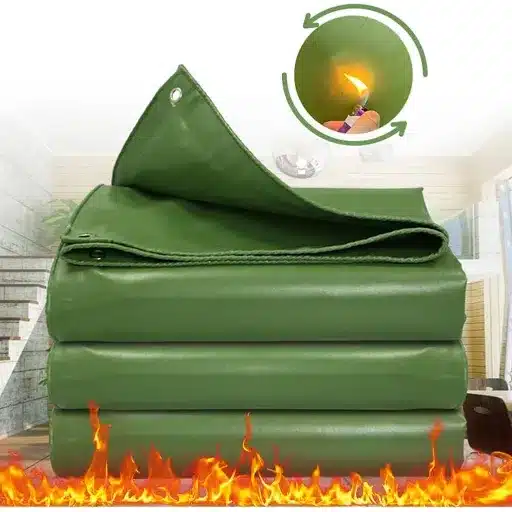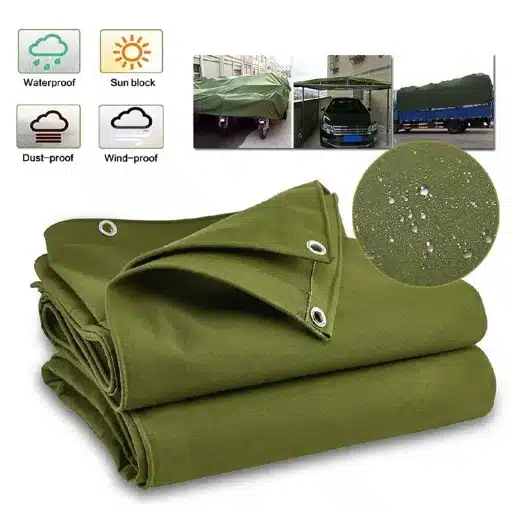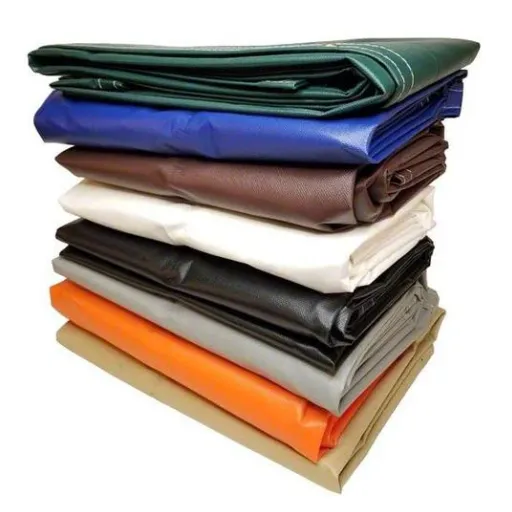When considering the quality and playability of a softball diamond, one finds that nature’s unpredictable elements must be defended against. Showers, bright sunlight, and other such environmental hazards inflict amounting damage on the field-aesthetic or functional. That is where the field tarps come into play. These important covers act like a layer of defense that keeps the field optimally maintained regardless of the weather. In case you are a coach or groundskeeper or facility manager, being able to appreciate the importance of a good field tarp is going to make all the difference in field maintenance. We will discuss some important benefits of softball field tarps, demonstrating why they have to be present in every well-maintained playing surface.
Understanding Softball Field Tarps
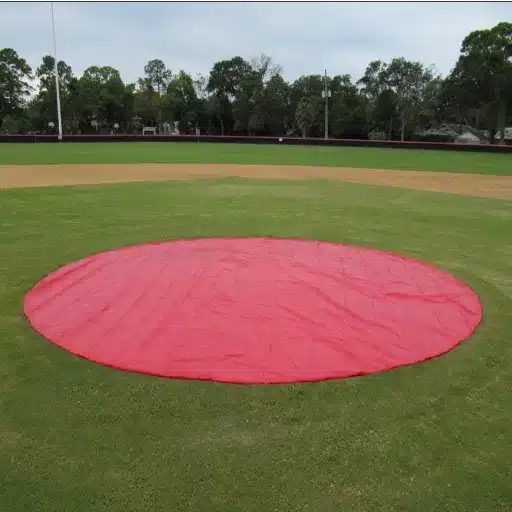
What is a Softball Field Tarp?
There are big-sized tarps used to protect the playing surface from rain or any other adverse weather conditions-they can also prevent frost or excessive sunlight. Being heavy and tough with materials such as polyethylene or vinyl, these field tarps are tear-resistant, UV-resistant, and water-resistant. The areas covered by these tarps may vary from the pitcher’s mound or home plate to the entire infield, making sure that the ground under care does not get wet and is suitable for a game. Softball field tarps play an integral role in the upkeep of the field by preventing it from being down long after a rainstorm and from inflicting greater damage to the field with extended exposure to the elements.
Importance of Field Covers in Softball
Field covers are important in keeping onto the softball field and working conditions. According to the latest information online, searches regarding softball field maintenance have shown increased interest in protective solutions, especially in the areas affected by extreme weather. Field covers protect key portions of the field from rainwater, which could pool and disrupt a game, thereby turning into a safety hazard for players. However, during droughts or heavy sunlight, these covers could protect the field from cracking or drying out; thus, protection ensures the playing surface throughout the year. Reduced maintenance time, fewer repair costs, and fewer field layoffs give the individuals that use these fields more time to prepare for the upcoming event—a factor that is of importance for players, coaches, and any future organizers.
Differences Between Softball and Baseball Field Tarps
Tarps safeguarding these playing fields are quite different because of the differences in the dimensions, layouts, and exigencies of each sport, though softball and baseball fields have many things alike. Typically, the tarps used for softball fields tend to be smaller because of shorter base paths and a much smaller outfield area in comparison to baseball fields, which, being larger, require a lot of tarp cover, especially towards side mound, home plate, and large outfield sections.
Again, other distinctions may arise from depending on the weight allowed and how the material is used, depending on the very purpose of the sport. Ideally, they tend to be more on the heavier and resistant side, to endure prolonged rain protection of much bigger and more complicated layouts of baseball fields; on the other hand, it is of utmost importance for softball tarps to be easier to handle and deploy quickly due to smaller fields.
Other tarps are developed to suit the peculiarities of the respective sport considering other factors such as size and durability. For example, in softball, the pitcher’s circle can generally be quite large and may require an appropriate cover; in contrast, baseball may employ covers for pitcher’s mound and home plate for some serious protection on these areas. According to the size, weather conditions, and use, the best suited tarp for either field may be selected for maximum protection and playability of the two sports.
Types of Softball Field Covers
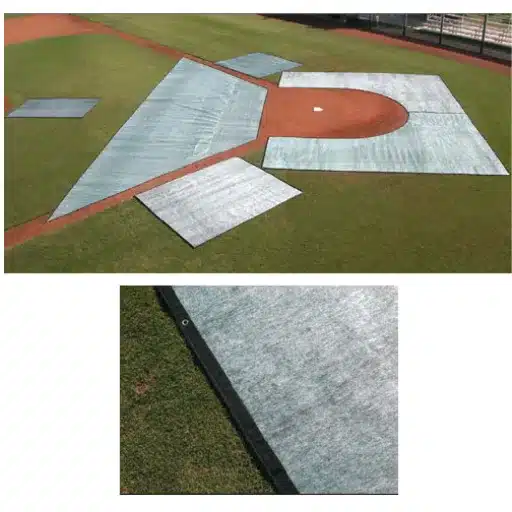
Infields Tarps vs. Outfields Tarps
When giving infield and outfield tarps a comparison, it is worth considering their usage and application areas. Infield tarps mainly protect the pitcher’s mound, home plate, and base paths, as these points are most susceptible to rain and allowed moisture damage. Keeping these tarps over the infield ensures these critical areas stay dry and apt for use during short downtimes in games or practice sessions.
Outfield tarps, however, work on covering vast outfields. They cater particularly well for areas wherein prolonged rain or harsh weather come into play. Due to their size and the logistics of deployment, outfield tarps are less in use than infield ones; however, when it really matters to maintain breeding grass and fine soil, an outfield tarp would come into consideration.
Search earnings data shows that a good number of people are also looking for solutions that include lightweight materials and ease of deployment. The latest innovations into tarp manufacturing incorporate UV-resistant fabrics and reinforced-edges, which make infield and outfield tarps far more durable and user-friendly. Depending upon the usage-level and weather conditions, a purchase of the right kind of tarp, in that case, can go a long way in maintaining the field in good shape while safeguarding the athletes entering play.
Heavy-Duty Tarps for Maximum Protection
In field care, the heavy-duty tarp is the principal investment for utmost protection. Per recent search trends on , many users ask about heavy-duty tarp attributes and how it is better compared to regular tarp options. High-grade materials and designs used in these tarps give them the ability for higher tear, puncture, and extreme weather-resistance. Additional coatings for UV protection and waterproofing are then applied, creating a chemical makeup more suitable for long-term field protection application. Heavy-duty tarps reduce maintenance costs and help athlete performance by keeping the fields consistent, be it through heavy rain, long hours of sun exposure, or debris.
Materials Quality in Tarps
Heavy-duty tarps derive their name from the plethora of first-rate materials engineered to bring forth durability and working ability. Most commonly, one sees high-density polyethylene (HDPE), polyvinyl chloride (PVC), and canvas tarps given that these three stand for strength and multipurposes. HDPE tarps are deemed the lightest and yet firmer amongst all, being impervious to tearing or stretching, whereas PVC tarps have the best waterproofing ability with UV resistance, suitable for being exposed to sunlight and adverse weather conditions for long durations. Additionally, canvas tarps allow for air transfer and eco-consciousness in projects where minimization of condensation and environmental concerns are a priority.
Back in the days, a tarp was very much like a blanket. Today, modern tarps upheld by tarp manufacturers combine the traditional know-how of manufacturing with cutting-edge moving trends, such as tighter weave patterns and double or triple-layer coatings. These can definitely render all other finishes obsolete because these give the perfect answer to all considerations of durability and reliability for industrial, commercial, and recreational uses, all at an affordable price for the consumer.
Benefits of Using Softball Field Tarps
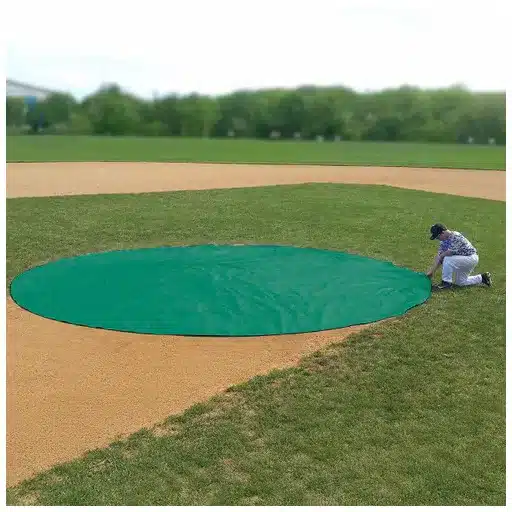
Extreme Weather Protection
Players field tarps serve to protect the field from inferior weather conditions. Flooding, excessive heat, sun, hail, and frost are some of the damaging elements a tarp will try to suspend from making their negative impact on the field. Search trends, query data, and user frequency have indicated that an abundance of queries are concerning the issue of water pooling on baseball tarps. Contemporary tarp designs have dealt with this problem by incorporating drainage and water-resistant materials so that fields stay dry and can quickly be put into play after bad weather. This prevents water damage to the field, reduces the cost of upkeep, and increases greatly the life of the field.
Maintaining Turf Quality and Longevity
One of the most common inquiries from users, according to the search data, is: how do we keep our turf surface in good quality, especially in traffic areas, yet ensure its longevity? True turf management requires one to exercise firm proactive care and make use of innovative solutions. On aeration days, there must also be overseeding, keeping the turf properly watered so the soil underneath does not get compacted and able to grow new grass. Furthermore, very hard turf reinforced with synthetic fibers can withstand a lot of wear and tear without degrading field performance. Advanced maintenance systems, such as GPS-guided mowers and moisture sensors, also provide invaluable assistance in gathering data for monitoring and optimizing turf health. With the use of modern technologies and considering these turf management strategies, field managers can safeguard the turf from eventualities, to keep it resilient, pristine, and catering to athletes and spectators alike.
Profitability of Investment
Okaying a relatively expensive turf reinforced with synthetic fiber and advanced maintenance tools has proven to be a cost-effective solution for field management. Recent studies have shown fields with these latest technologies require fewer replacements and spend relatively less on maintenance costs than traditional natural turf over time, implying great savings in the long term for a facility manager. Search trends tend to illustrate increasing interest in sustainable and technically advanced turf solutions, which implies that such investments are not only money-saving but they also correspond to the bigger industry and environmental priorities. By making possible the reduction of downtime and increasing turf life, decision-makers achieve their highest ROI while ensuring high performance and sustainability.
Choosing the Right Softball Field Tarp
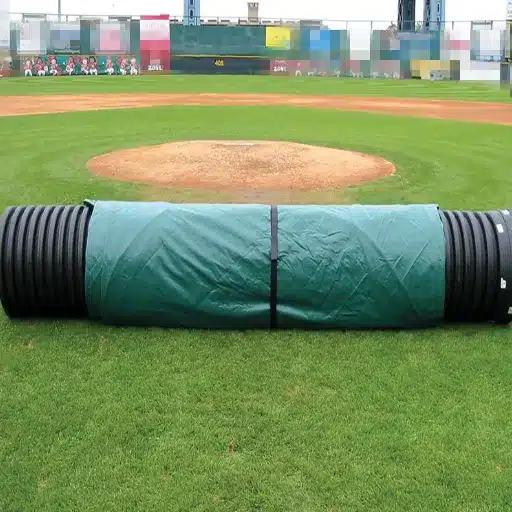
Factors to Consider: Weight and Size
Depending on the weight and size of a tarp during its selection, workers and facilities find these two greatly influencing usability and efficiency. The heavier the tarp, the more durable it could be; it would also offer greater protection from severe weather conditions, but then it would take more effort and manpower to put it on or take off. Lighter tarps, in contrast, are easier to handle, carry, and maneuver and would thus be ideal for smaller teams or facilities. They should be sized to match the dimensions of the field to be fully covered without any extra material that could become a hazard. Search data from recent times also reveals users want their tarps to be durable yet easier to work with-the in-between solution: a tarp that is strong but easy to handle. Considering the above, one can arrive at a mature decision that satisfies the pros and cons of value.
Understanding Tarp Covers and Their Uses
Tarp covers serve diverse set of functions, rendering them highly adaptable for various industries and applications. They include, but are not limited to, coverings for machinery to protect them under accuracy, covering items under severe weather conditions, or for covering a large area, such as a field or construction site. Using the latest information from ‘s search engine, users mostly would look for tarp covers having such features as tiny durability, weather resistance, and easy handling. This clearly shows an elevated demand for product combinations of utmost performance and ease of use. Hence, depending upon this, manufacturers must take the next line of tarp covers that are as light as possible without sacrificing strength, to allow its easy handling and installation in tough conditions. When endowed with these features, then tarp covers will definitely be the choice for individuals and companies alike that require a good protective cover.
Selection Guide
While choosing the exact tarp cover, it is paramount to first consider factors related to material quality, size, or intended use. Trend anticipation by ‘s indicates users mostly rank UV resistance, waterproofing, or ease of storage as some of the advertised selling points for tarps. Go for materials such as polyethylene or vinyl, which promise the highest durability with excellent weather resistance. Size is intimately tied with full coverage in that neither should the surface be too small or too bulky. The user who searches for something with distinct functionalities may opt for enhanced features such as reinforced grommets or flame resistance for considerable long-term usability, for example, construction, outdoor storage, or camping. With these factors in consideration, your chosen tarp cover is bound to serve you perfectly well for your needs.
Storage and Maintenance of Softball Field Tarps
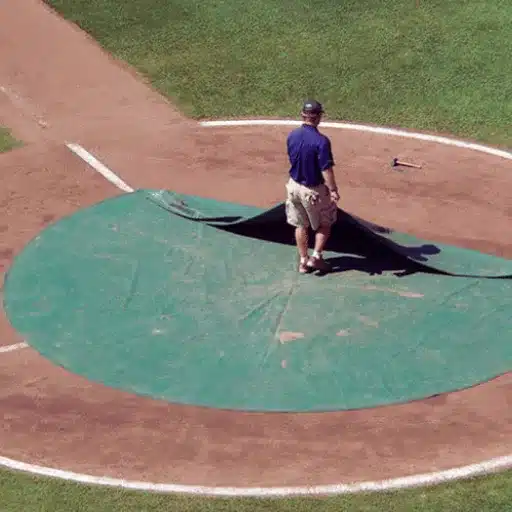
Storage Tips for Tarps
The correct storage of softball field tarps is among the prime requirements for extending their service life and retaining unexpected strength. At the outset, the tarp must be absolutely clean and dry, as dirt or moisture buildup will eventually encourage mildew, which will either keynote the condition of the tarp or even destroy it. The folding of the tarp involves a systematic sequence from edge to center, so as to avoid creasing and developing faults. Always keep tarps in a cool, dry area, away from harsh sun rays and extreme temperature because prolonged exposure to these extreme elements can prove detrimental to the fabric.
Use tarp bags or bins as storage to safeguard the folded tarp against dust, pests, and environmental elements. For maintenance of heavy-duty field tarps, consider attaching an additional storage rack or tarp roller, thereby facilitating easier handling and maintaining the structural integrity of the tarp. Modern data has it that placing tarps atop something, away from the floor, significantly reduces the chance of rodent damage and accidental punching. Following these best practices will maintain the tarp’s durability and functionality, thus ensuring it still does what it is supposed to do efficiently even after some time.
Regular Maintenance Tips
Clean Your Tarp Regularly
With the passing of time, dirt, debris, and moisture can settle, accelerating the decomposition of the tarp material. Using mild soapy water, scrub the surface with either a soft brush or a sponge. Rinse the tarp and allow it to dry thoroughly before putting it away; otherwise, mold and mildew might grow.
Inspect for Damage
The windows and tear punctures form weak spots. These awful points then need to be repaired further with a special tarpaulin ointment or tape. It is best to act quickly in case of any damage before further deterioration sets in.
Protect From UV Damage
Constant exposure to sunlight may induce weakening of the tarp structure. Go for UV resistant tarps or give a spray of UV protectant during cleaning to lessen sun damage and prolong life.
Store Properly
Combining the latest data converged from search suggestions, storage of tarps in a cool, dry place away from the ground better protects against environmental concerns and pests. Rolling a tarp rather than folding it into a bundle would reduce creases and stress, helping preserve it better.
Adhering to these methods and adopting routine scrutiny and care will pay off in the long run in ensuring a dependable tarp.
Storage Rollers for Convenience
Using storage rollers for your tarps guarantees convenience while also playing a huge part in prolonging their life. According to recent data analyzed regarding search trends, storage rollers maintain a uniform distribution throughout the material, thus minimizing the development of stress points, folds, or wrinkles. It facilitates the handling of large or heavy tarps, reducing the effort required to place or deploy it. Rollers also limit contact with abrasive surfaces that could cause wear. For those working at moving or accessing the tarp constantly, storage rollers save time and effort and, at the same time, extend the life of the material. When combined with careful use and regular inspections, storage rollers are almost a guarantee in keeping your tarps at their best while maximizing durability.
FAQ
What are the benefits of using a softball tarp?
Softball tarps are an essential shield aimed at protecting baseball and softball fields from rain showers and moisture. Such protection keeps the field in a playable condition so that muddy surfaces do not lead to cancellation of any game. High-quality tarps are made from durable materials such as density polyethylene. The tarp can, in turn, save the time needed for field preparation, with more time for practice, and games for the teams. Such tarps would be worth investing in, while giving you peace of mind that your field will be protected from the unpredictable element.
What should I consider before picking the right field cover for my baseball field?
Choosing the perfect baseball field cover involves quite an array of criteria: size, type of material used, and application. Tents must be made from the best-grade heavy-gauge materials capable of resisting unforgiving weather. They are often custom-ordered for specific field dimensions to assure full cover. In some cases, you may want to consider its ease of handling; certain tarps come with storage rollers, which make setting up and taking down more convenient. Whenever games are cherished on your field on a regular basis, getting a gritty tarp to shield it against the elements is crucial, so it remains ready for league baseball teams. Also, an extra consideration could be the weight of the tarp: a lighter tarp is easier to handle.
Are there special softball field tarps and infield covers?
Absolutely, softball field tarps do exist for the infield, often referred to as infield covers. These tarps are designed to be deployed over the infield dirt and pitching mound areas to protect them against rain and moisture. Great infield tarps come in many sizes to fit snugly with the dimensions of a field. Most of the best models will also be constructed of superior materials that ensure maximum durability and protection. An infield tarp should therefore be chosen carefully, considering weight, ease of installation, and perhaps accessories like stakes or sandbags, so that the tarp can be held down during windy conditions. Having the appropriate infield cover will go a long way toward protecting the life of your field.
How to properly store the softball field tarp?
Such storage is very crucial in confirming the tarp’s longevity and utility. After its use, the tarp must be cleaned and dried completely to avoid any development of mold and mildew. When rolling up the tarp for storage, one could also use a storage roller to ease the whole process and keep things organized. Store the tarp in a cool, dry place, away from sunlight because of possible material degradation. If you are going to have a stack of tarps, it might help to label them by size or purpose to distinguish them quickly when needed; for example, labeling infield or mound coverage tarps. This storage leads to having tarps ready for use in the best condition possible for the next game.
What materials are best for heavy-duty softball field tarps?
This is a list of materials best suited for heavy-duty softball field tarps and consist mainly of high-density polyethylene and other tough synthetic fabrics that provide excellent water resistance and UV protection. These materials resist outdoor rigors such as those inflicted by rain, sun, and wind. Some features to look for include reinforced edges and grommet holes for easy securing by stakes or sandbags. Also, tarps with a woven design are recommended as they offer greater strength and sturdiness. Buying a tarp made from the best materials will keep your field well protected for many seasons.
Reference Sources
- Tales from the (Softball) Field – Explores the role of softball fields in various contexts, providing insights into their management and use.
- 1999 Morehead State Softball Roster – Mentions the development of softball field infrastructure, including tarps, offering historical and practical perspectives.
- Northwest Education, Volume 6, 2000-2001 – Discusses the role of sports fields in education and recreational activities, relevant to understanding field maintenance needs.

